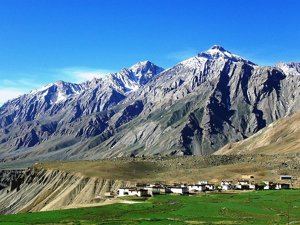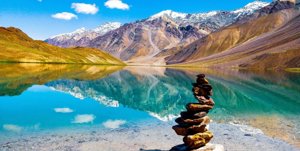Spiti Valley, nestled in Himachal Pradesh, is one of India’s most mystical high-altitude cold deserts, celebrated for its breathtaking landscapes, unique cultural blend, ancient history, and rising tourism.
Location and Geography
Spiti Valley, meaning “The Middle Land,” lies in the northeastern corner of Himachal Pradesh, bordering Tibet to the east, Ladakh to the north, Lahaul to the west, Kullu to the south, and Kinnaur to the southeast. The valley, situated between altitudes of 3,000–4,587 meters, is carved by the Spiti River, flanked by side-valleys such as Pin and Lingti. Its cold desert environment is marked by dramatic, rugged terrains, sparse vegetation, isolated villages, and pristine Himalayan lakes.
Key Details:
History of Spiti Valley
Spiti Valley boasts a legacy dating back over 3,000 years. Ancient rock art found across the valley points to prehistoric habitation from the Late Bronze Age to the Iron Age. Historically, Spiti was part of the ancient kingdom of Zhang Zhung, and later saw a flourishing of Tibetan Buddhism after the arrival of Tibetans. The area remained relatively isolated due to its harsh terrain and climate.
During the ancient and medieval periods, Spiti was ruled by local Rajput dynasties and monasteries played key roles in social and spiritual life. The valley only truly opened to tourism and the outside world in the late 20th century.
Culture and Spirituality
Spiti Valley’s culture is a harmonious blend of Tibetan Buddhism and Hinduism, reflecting centuries of interactions between Tibet and the Indian Himalayas. Guru Padmasambhava’s teachings strongly influenced the region, introducing Mahayana Buddhism alongside local spiritual traditions.
Villages such as Komic, Langza, and Hikkim are rich in folklore, ancient rituals, and sustainable living. Festivals, chants, and vibrant prayer flags characterize everyday life. Spiti hosts some of India’s oldest monasteries, including Key, Tabo (over 1,000 years old), and Dhankar, showcasing sacred art, scripture, and living Buddhist heritage.
Crafts such as pottery, carpets, and shawls remain vital, and the region’s food, based on barley, potatoes, and peas, is simple but nourishing. Hospitality is central, with travelers welcomed into local homes and homestays.

Major Tourist Attractions
Spiti Valley is a haven for adventure seekers, nature lovers, and those pursuing spiritual journeys. Key highlights include:
- Chandratal Lake: Crescent-shaped, crystal-clear, set amidst high mountains; ideal for camping beneath the stars.
- Key Monastery (Kye Gompa): Largest and oldest Tibetan monastery in Spiti, a center for learning and spiritual practice.
- Pin Valley National Park: Sanctuary for snow leopards, ibex, blue sheep, and red foxes; great for wildlife enthusiasts and trekkers.
- Kunzum Pass: High motorable pass; gateway to Lahaul, offering spectacular Himalayan vistas.
- Tabo Monastery: Over 1,000 years old and often described as the “Ajanta of the Himalayas”.
- Kibber Village: One of the highest inhabited villages; base for treks, wildlife viewing, and the famous Chicham suspension bridge.
- Langza, Hikkim, and Komic: Langza is known for its giant Buddha statue and fossils; Hikkim features the world’s highest post office; Komic is the highest motorable village.
Adventures include motorbike tours, trekking (Pin-Parvati and Pin-Bhabha passes), river rafting, camping, photography, and unique experiences such as sending a postcard from Hikkim.
Access: Routes to Spiti Valley
Reaching Spiti Valley is an adventure in itself, with two main routes, open most of the year depending on weather conditions:
- Delhi/Chandigarh–Shimla–Spiti Route: Open year-round, best for steady travel. Route: Shimla→ Rampur Bushahr→ Powari→ Nako→ Tabo→ Kaza.
- Delhi/Chandigarh–Manali–Spiti Route: Open only in summer, snow blocks the Kunzum Pass in winter. Route: Manali→ Rohtang Pass→ Grampu→ Batal→ Kunzum Pass→ Kaza.
Road quality varies from tarmac to dirt and stone; landslides and harsh weather can impact travel. Tours via private car, motorbike, or organized groups are popular.
Economy and Tourism Revenue
Traditionally, Spiti’s economy was based on subsistence agriculture using ingenious irrigation along river channels. In recent decades, the focus has shifted to cash crops: garden peas, potatoes, barley, wheat, and limited apples. Road connectivity has transformed agriculture and market access.
Tourism is now a dominant revenue source. Spiti attracts thousands of visitors annually for adventure, wildlife, spirituality, and photography. Eco-tourism initiatives aim to ensure local communities benefit, preserve culture and environment, and minimize negative impacts. Local homestays, guides, and handicrafts are vital for community income.
FAQs About Spiti Valley
Where is Spiti Valley located?
Spiti Valley is in the northeastern region of Himachal Pradesh, India, part of the Lahaul and Spiti district, separated from Lahaul by Kunzum Pass.
What is the best time to visit Spiti Valley?
The ideal months are May to September, when both routes are open and the weather is milder.
How can one reach Spiti Valley?
By two main road routes: Via Shimla (open all year) or via Manali (closed in winter due to snow). Public buses, private taxis, and organized tours operate these circuits.
What are the must-visit places in Spiti?
Chandratal Lake, Key Monastery, Pin Valley National Park, Kunzum Pass, Tabo Monastery, Kibber village, Langza, Hikkim, and Komic are top attractions.
Is Spiti Valley suitable for solo or family travel?
Absolutely, its natural beauty, welcoming locals, and safe environment make it perfect for solo adventurers, families, and groups.
What is unique about Spiti Valley’s culture?
It’s a blend of Tibetan Buddhism and Hinduism, with unique festivals, monasteries, crafts, and sustainable lifestyles shaped by the harsh climate and isolation.
How many tourists visit Spiti Valley annually?
In 2022, Lahaul and Spiti districts received tens of thousands of tourists, and numbers keep rising due to improved accessibility and growing interest in eco-tourism.
What kind of accommodation is available?
Options include homestays with local families, guesthouses in villages, monastery stays, and hotels in Kaza, the region’s hub.
Is Spiti Valley good for wildlife spotting?
Yes, Pin Valley National Park is renowned for snow leopards, Himalayan ibex, blue sheep, and rare birds.
Is WiFi and mobile connectivity available?
Limited, all-weather mobile connectivity is patchy; Kaza has some internet access but remote villages may not.
Conclusion
Spiti Valley, Himachal Pradesh’s hidden gem, offers unmatched natural beauty, a living tapestry of ancient culture, thrilling adventure, and rare wildlife in a serene, spiritual landscape. Whether seeking tranquility in centuries-old monasteries, hiking to high-altitude lakes, or engaging with unique community-based eco-tourism, Spiti promises a transformative experience.
